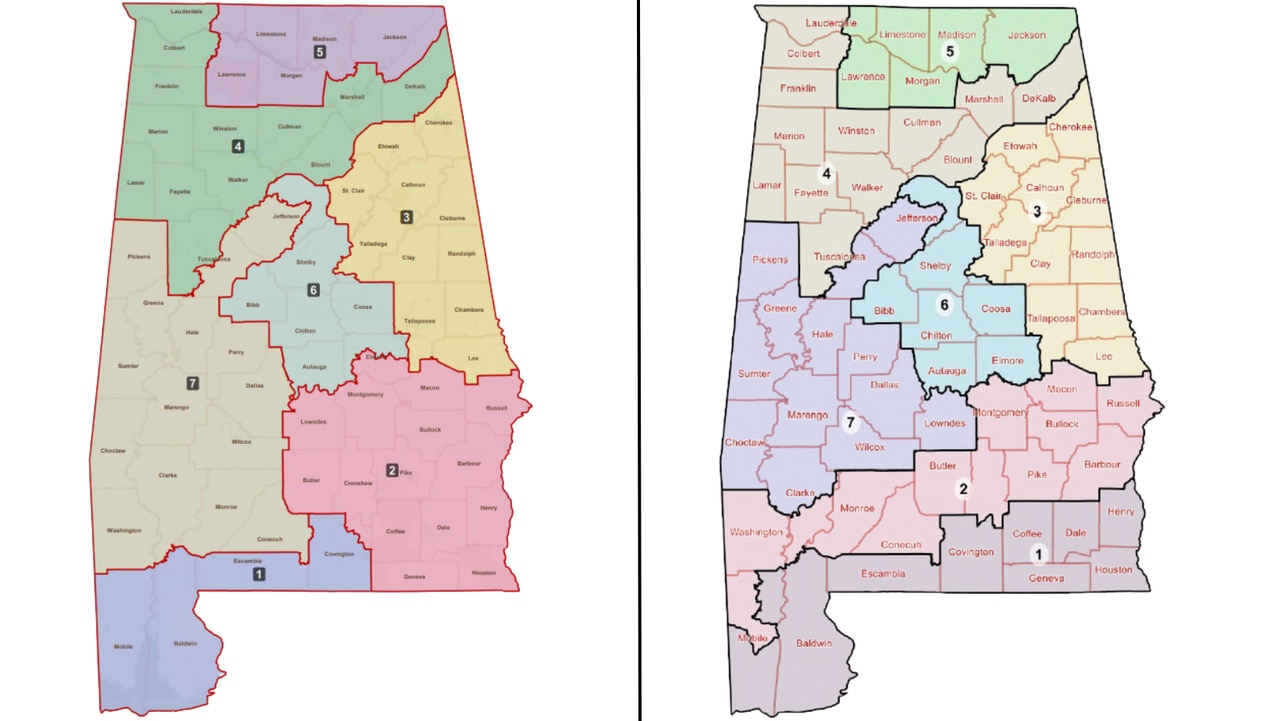Alabama objects to maps with 2nd Black opportunity district
Alabama’s lawyers filed objections Thursday to three congressional maps proposed by the special master appointed by a three-judge federal district court.
Attorney General Steve Marshall and Solicitor General Edmund LaCour wrote that maps submitted Monday by Special Master Richard Allen were racial gerrymanders. Marshall and LaCour represent Secretary of State Wes Allen, who is the state defendant in the case.
“Secretary Allen preserves his objection to these plans and maintains his argument that the districts based on this structure are unconstitutional racial gerrymanders that harm Alabama voters by subjecting them to racial classifications,” the lawyers wrote.
The three-judge court ordered the special master to draw the maps after ruling on Sept. 5 that the map approved by the Legislature in July failed to fix a likely violation of Section 2 of the Voting Rights Act. The court issued a preliminary injunction blocking the state from using the Legislature’s map in next year’s congressional elections.
The Legislature’s map left District 7 in west Alabama as the only majority Black district out of seven in a state where one-fourth of residents are Black.
The court had instructed the Legislature that the remedy to a likely violation of the Voting Rights Act found on the state’s 2021 map would require a second district that is majority Black or close to majority Black, one where Black voters would have an opportunity to elect a candidate of their choice.
The special master’s three proposed maps make District 2 in south Alabama the second opportunity district for Black voters. The plans raise the Black voting age population in District 2 to about 50%. A performance analysis based on recent election history showed the Black-preferred candidate would win most of the time in the redrawn district.
The special master’s plans are similar to a plan proposed by the two groups of plaintiffs, led by Evan Milligan of Montgomery County and Marcus Caster of Washington County, who filed the Voting Rights Act claim and who have prevailed so far in rulings by the three-judge court and the U.S. Supreme Court.
The state’s lawyers say the courts have been wrong.
“Secretary Allen preserves his argument that this Court’s preliminary injunction order was in error where it found that race did not predominate over traditional districting criteria in plans based on this structure or any other approach that sacrifices traditional criteria for racial goals,” they wrote.
The three-judge court and the Supreme Court have rejected the state’s arguments that the maps proposed by the plaintiffs in the case are unlawful racial gerrymanders.
On Tuesday, the Supreme Court denied Alabama’s request for an emergency stay in the case.
Thursday was the deadline for the state and others to file their objections to the special master’s maps.
The three-judge court has scheduled a hearing for Tuesday at the Hugo L. Black U.S. Courthouse in Birmingham.
Secretary Allen has told the court that a new map needs to be in place by early October to prepare for next year’s elections.
In Thursday’s objection filed with the court, the state’s lawyers said Remedial Plan 1 was the most objectionable of the special master’s three plans because “of its unnecessary split of Houston County” between Districts 1 and 2.
The special master’s Remedial Plans 2 and 3 place all of Houston County in the redrawn District 1. Remedial Plans 2 and 3 split a total of six counties, the same as the Legislature’s plan.
Special Master Allen, in his report and recommendation to the court, said the three remedial maps, drawn by cartographer David Ely, were not racial gerrymanders.
“The Special Master and cartographer emphasize that they did not use any measure of Black population or voting age population as a proxy for performance,” Allen wrote. “Districts were not drawn to attain any particular threshold of Black population, such as 50%.
“Rather, after they were drawn, districts were tested to determine how often the Black-preferred candidate would win elections within those districts. and that the districts were not drawn so that districts to hit a target on the percentage of Black population.”
Special Master Allen wrote the the proposed maps minimized changes to the Legislature’s plan to the extent possible by maintaining most boundaries and keeping the vast majority of people in the same districts. Districts 3, 4, and 5 were identical to the Legislature’s plan, and changes to Districts 6 and 7 were minimal, Allen wrote.
Allen, a former chief deputy attorney general under four Republican attorneys general, wrote that in addition to the plan proposed by the Milligan and Caster plaintiffs that is similar to his proposed maps, he considered maps proposed by seven other individuals or groups, including one proposed by a plaintiffs group led by Senate Minority Leader Bobby Singleton and one proposed by the Alabama Democratic Conference, the Black caucus of the state Democratic party.
Read more: Alabama Democratic Conference to propose a redistricting map Joe Reed says has more Black voters
The map passed by the Republican-controlled Legislature in July, left, and Remedial Plan 3, proposed by Richard Allen, special master appointed by a three-judge federal district court. The court blocked the use of the Legislature’s map because it did not add a second opportunity district for Black voters. The special master’s maps make District 2 in south Alabama a second opportunity district, along with District 7. (Monica Keener/[email protected])
